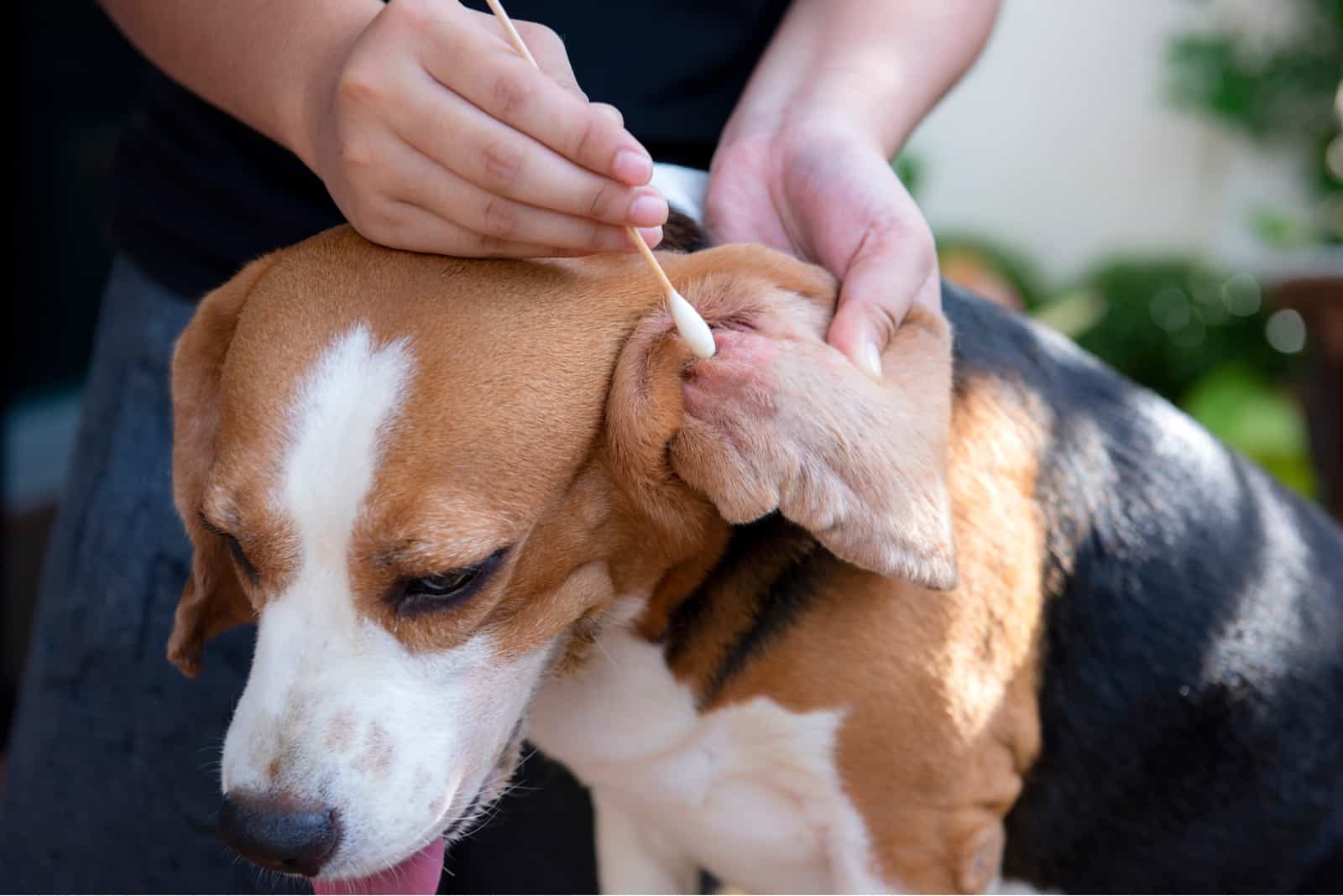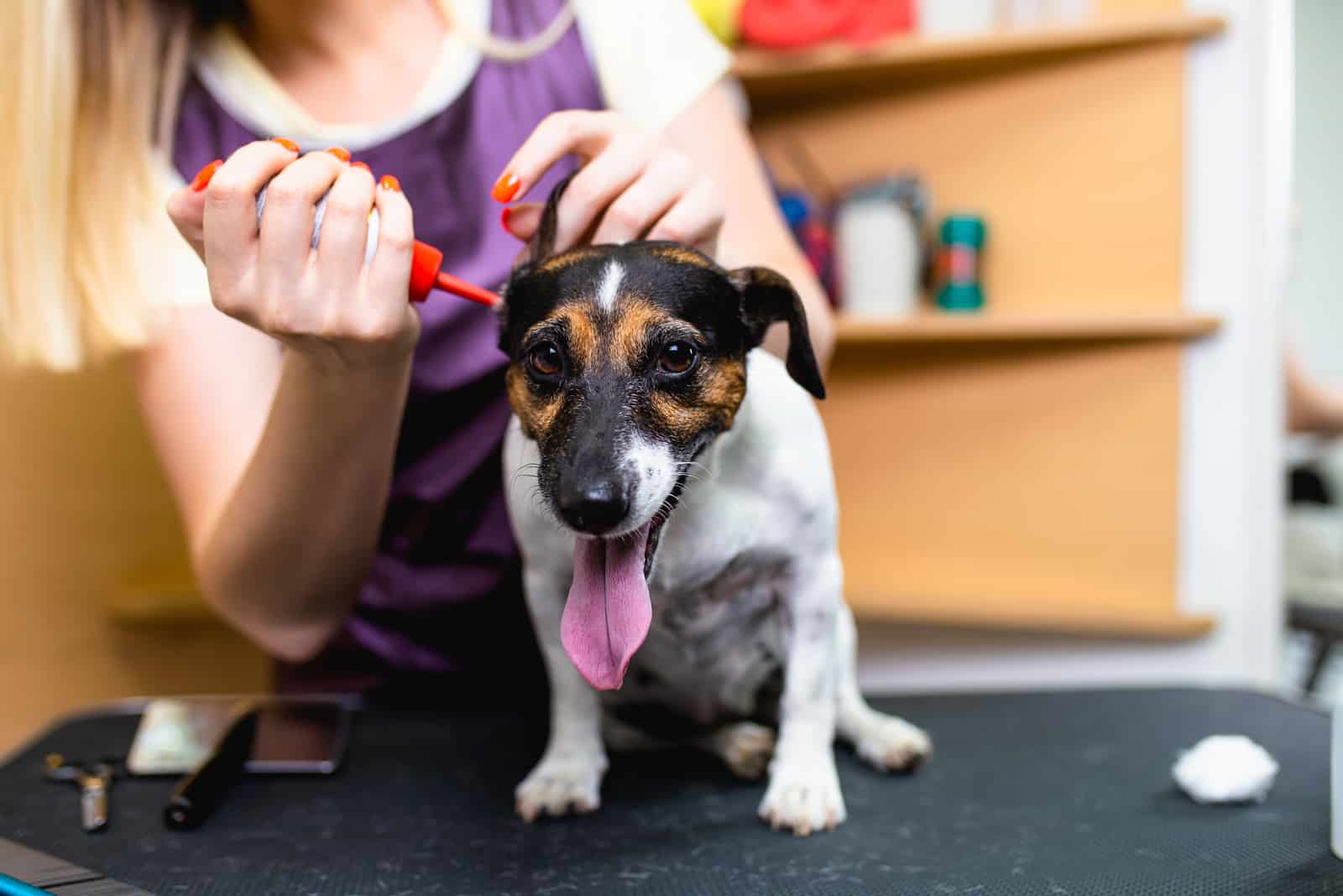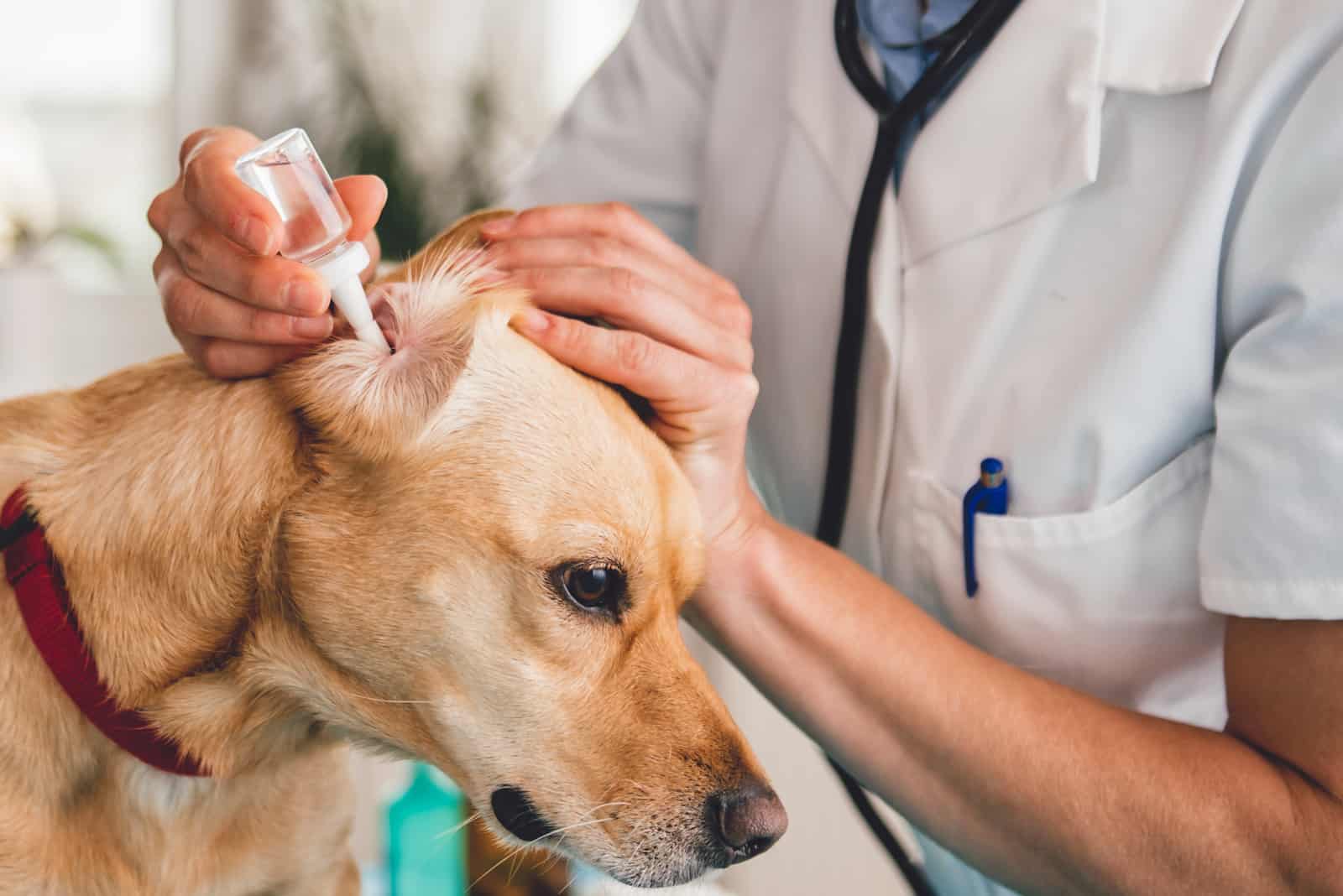One of the most important things to dog owners is their dog’s health. Even the smallest inconveniences can make us worried. Sometimes, when talking about ear problems, one can think that this isn’t the biggest deal, and that there is much worse stuff that your dog can suffer from.
But, that is completely wrong. Ear problems can cause a lot of pain and discomfort to your doggy. Yes, sometimes they aren’t necessarily really bad, but they will always aggravate your dog. The worst thing that can happen is a chronic ear infection .
Ear wax can cause a lot of problems for your dog. It is a natural thing that is the key to keeping your dog’s ears healthy. Ear wax helps to remove dust and chemicals, and in that way, it prevents damage. But, if a buildup of an excessive amount of ear wax occurs, there either will be a problem or a problem is already present.
We are here to talk about black gunk in dog ear , what it means, how to clean it, and present you with some information about ear infections .
Black Gunk In Dog Ear: What Causes Black Ear Wax In Dogs?
The other name for ear wax is cerumen, and it forms in the external parts of the ear canal . Since it has an oily texture, it can stop water from going into a dog’s ears . It also prevents debris, dust, bacteria, dead cells, and even some chemicals from shampoos.
Excessive ear wax can be a concern, especially if it changes colors. Have you ever wondered what that black gunk in a dog’s ear is ? Well, there can be a couple of reasons for that. Unfortunately, black and dark brown ear wax usually means that there is a more serious problem.
We will present you with the three most common causes of black ear wax , or as people call it, gunk , in your dog’s ears .
RELATED: Dog Earwax Color Chart: Everything You Need To Know
1. Dirt

Firstly, we wanted to start with a cause that is, at the beginning, the least dangerous one, but if not taken care of, it can cause serious problems. This can happen if you have a back yard where your dog frequently explores. When dirt gets stuck in a dog’s ears, it usually resembles coffee grounds.
Another thing when this can happen is if you spend a lot of time outside in nature, especially with dogs that have floppy ears . Dogs with floppy ears that are covered with long hair, like Cocker Spaniels, can get a lot of dirt in their ears.
This is the reason why you need to regularly check your dog’s ears and try to clean them at least once a week. If you don’t feel comfortable cleaning your dog’s ears, you can always go to the vet or the groomer.
Even if the dirt seems harmless at first, and can appear in your dog’s ears as dark or light brown, or even black, you need to get it out as soon as possible. Your dog will probably do a lot of head shaking, and its ears will be really itchy . If the dirt stays in there for a long time, it can cause an ear infection .
There isn’t a way to prevent dirt from getting into your dog’s ears . This is why it is important that you check your dog’s ears every time you get home from a walk or playtime.
2. Yeast Infection

Any kind of inflammation in a dog’s outer ear is called otitis externa . If you see your dog shaking its head, itching its ears, having a weird smell coming from its ears, or see black or dark brown gunk , you might be having a problem with a yeast infection .
This fungal infection can be caused by Candida. Another yeast that can cause your dog to have inflammation can be Malassezia.
If you swipe a cotton ball through your dog’s ear and it leaves a dark brown or black oily mark, you can probably count that this is a yeast infection .
Signs Of A Yeast Infection
Sometimes, if you see your dog behaving a bit strangely or aggravated, the reason might just be a yeast infection in its ears. We will list some of the symptoms so if you notice them, you should immediately check your dog’s ears and take it to a doctor of veterinary medicine (or DVM) .
One of the things that can probably ease your concern right away is if your dog’s ears are cold . Any type of inflammation will cause your dog’s ears to be hot.
– Drooping ears
– Huge amounts of black or dark discharge
– Inside of the ear can be swollen and read
– Smell from the ear (musty, like an old shoe)
– Very itchy, with constant scratching
– Head tilting
– Head shaking
– Inflammation
– Your dog seeming to be disoriented and aggravated
– Scabs and thinning fur around the ear area mostly because of scratching
– Loss of balance
– Unusual eye movement
– Excessive ear wax or debris
– Restlessness during the night
Yeast can also appear in other parts of the body. Sometimes, it is an indication if your dog has the symptoms that we already listed, and the symptoms that we will list, of a yeast infection .
– Crusts that can be flaky and gray
– Red bumps that are usually very small
– Dark and thick skin in some areas (mostly armpits and groin)
– Redness between the toes
Unfortunately, sometimes an ear infection that is caused by yeast can be associated with an underlying cause , such as
– A ruptured eardrum
– Bacterial infections
– Allergies
– Tumor or polyp in the ear canal
– An object that is trapped in the ear
Causes Of An Ear Yeast Infection

Yeast is always present in your dog’s ears , but there are some factors that can cause it to get out of control and cause your dog to have problems. This means that yeast infections aren’t only superficial.
An overgrowth of yeast in the ear can be caused by an overgrowth of yeast in your dog’s body. There are a couple of reasons why this can happen, and we have prepared them for you.
1. Moist Or Oily Skin
If you are dealing with Malassezia, you need to know that they are lipophilic, which means that they like lipids (fats). This explains why dogs with oilier skin, or even coats, are prone to Malassezia.
Dog breeds, or dogs in general, that like to spend a lot of time in the water can catch this yeast because of the constant dampness of their coat , especially dogs that have floppy ears because the ear flap can cause moisture to stay in the ear longer.
Dark and damp places are heaven for yeast to develop. This is why it is important to dry your dog’s ears completely after taking a bath or after a visit to a lake or the sea. You can use cotton swabs or a towel, but make sure to get in there without damaging the eardrum .
2. Heavy Metals
Heavy metals and other environmental toxins can cause some harm to your dog’s gut. They can have an effect on the beneficial bacteria in your dog’s gut, which can cause yeast to overgrow.
Some of these heavy metals and other toxins can be found in vaccines, cleaning products, flea and tick preventatives, and even food and water. This might sound scary, but don’t stress too much. This happens rarely.
Some dogs just have more sensitive guts and might be more prone to yeast infections . If you have suspicion that this might be your dog, take it to the vet just to be sure.
3. Medications
We all know that meds can have some side effects. Some of the consequences of antibiotics are that they destroy good bacteria while destroying bad bacteria. Therefore, because of the absence of good bacteria, yeast can grow freely.
Sometimes, yeast infections can be caused by allergies. When the vet assumes that your dog is suffering from allergies and gives it immune-suppressing allergy medications, this can actually cause them even more problems.
These medications can cause even faster yeast growth in a dog’s body, which is bad, especially if it is already having problems with an ear yeast infection. Sometimes, it is difficult to diagnose the specific cause of this problem.
This is why it is important for you to follow your dog’s behavior and ear condition after returning home from the vet. If you see that the meds aren’t helping, or are making the situation even worse, you should immediately call the vet for a different diagnosis.
4. Ear Deformities
Some dogs have different-looking ear canals or have excessive ear tissue. Dog breeds like the Shar-Pei are known for being prone to ear problems since their ear canals are a bit different from other dogs.
Other dogs, which don’t depend on the dog breed , can develop ear issues over time because of some trauma or ear infection . The main thing these deformities can cause is wetness of the ear.
What does that mean? Well, these abnormalities make it difficult for the moisture to get out, and because of that, it is more difficult for the ear to stay dry. Because of this, the perfect environment for yeast is created.
5. Allergies
If your dog has allergies to something from the environment, or food allergies , or even flea allergies, you can expect that it can potentially develop into a yeast infection . Because of the allergies, there can be an overgrowth of yeast in the dog’s ear .
The way the body reacts to any allergen is inflammation. This can cause yeast to build up in the ears, which is why it is best to do an allergy test while your dog is still a puppy. Allergens from the environment can be harder to detect.
6. Ear Shape
As you can guess, dog breeds with longer ears can be more prone to getting a yeast infection . Some of those dogs are Cocker Spaniels , Poodles, Basset Hounds, etc. The problem with these kinds of ears is that they collect moisture.
They make it very difficult for the ear to get dry. As we have already mentioned, a place that is dark and wet is the perfect environment for yeast to grow freely.
Sometimes, dog owners wonder if cropped ears can be a cause of yeast infections . Well, with cropped ears, you can easily see the ear wax , so it is easier to clean your pet’s ears , and it is easier to notice if an infection has occurred.
Yes, some dirt and water can get in there easier, but there are earplugs you can use when you know that your dog will be swimming the majority of the day. Even if water does get in, it is easier for cropped ears to dry out.
3. Ear Mites

You may be wondering what ear mites are . Well, they are microscopic parasites that resemble small spiders and ticks, and they infest the external ear canal of dogs, and also cats. The most common ones are Otodectes cynotis. These guys can get really annoying.
They can lay eggs on your dog’s skin pretty quickly. Just after four days, you can expect those laid eggs to hatch. Those young mites turn into adults in three weeks, and those adult mites can live for two months.
They are mostly positioned in the ear, but they can sometimes go to other body parts, but this is rare. When they are in the ear, they bite the skin to get to the blood. Their source of energy is blood and ear wax .
Signs Of Ear Mites
Some of the signs are similar to various ear infections , but some are more related to ear mites . Signs of your dog having ear mites are:
– Redness in the ear
– Head shaking
– Your dog intensively scratching its ears
– Black build-up
– Red dots (that are usually caused by the bites of the mites)
– Crusty skin around the ears
– Lack of hair because of scratching
When your dog gets ear mites, usually both ears get infected. The good thing is that they are usually easy to detect, and your vet can give you the needed medications straight away.
Side note: Topical medication that your vet will prescribe you is the best option. There are over-the-counter medications that you can purchase, but you need to be aware that they aren’t as effective as the ones that your vet gives you.
The medication your vet gives you can help your dog within seven to 10 days while over-the-counter medications might take three to four weeks to help your dog.
Causes Of Ear Mites
There isn’t much you can do to prevent your dog from getting these little pests. The way your dog can get infected with ear mites is by just walking around where there are a lot of trees and grass. So, if you are spending a long time outside with your dog, and if that area happens to be infested with mites, your dog is possibly infected.
Another way your dog can get them is by passing by or playing with a dog that is infected. You need to know that mites are very easily transmitted from dog to dog. So, as you can see, there isn’t much you can do.
The only thing that may help detect the problem as soon as possible is by examining your dog’s ears after a long time spent outside. Also, you can find some useful advice in our article on how to get rid of mites on dogs.
A Step-By-Step Guide On How To Clean Your Dog’s Ears

The good thing when it comes to cleaning your dog’s ears is that it doesn’t cost you a lot of money to do. But, on the other hand, it for sure can be a hassle. Dogs don’t really like to be touched around their ears, so giving them a cleaning session can make them uncomfortable.
But, cleaning your dog’s ears is a necessity that is crucial for their hygiene and health. Before we start with the list, we want to emphasize that if you see that your dog’s ear is irritated, smelly, red, or generally different looking – don’t clean them.
Take your dog to the vet because there might be a problem that can only be increased by you cleaning their ears. It is best to let a professional clean them and figure out what might be the cause of the problem.
Now that we got that out of the way, we can start with our guide on how to clean the ears.
Step 1
You prepare your dog for the process. Use a gentle tone and prepare their favorite treats. Prepare everything that you need, which is cotton balls , ear drops (this is the best if you consult with a vet), and an ear cleaning solution (a good example is an epi- otic cleaner). Try not to use any other cleansers or solutions – only the ear cleaner.
We also don’t recommend using cotton swabs (in other words, Q-tips) . These can only damage the ear canal and sensitive areas. They can also push the ear wax further into the inner ear and cause a build-up .
Step 2
After you have prepared all the necessities, now you need to prepare the dog. Make your dog as comfortable as possible. One hand will serve as a pillow for your dog’s head while your other hand will gently navigate the dog’s head to lean onto your arm.
After your dog is comfortable with its head tilted, you put the solution in the ear. Try to avoid contact between the applicator and the ear. After you put in the ear cleaner, you will need to massage the ear for about 40 seconds.
If your dog has longer ears, you can do this by using the flop to close up the ear and then massage it. If your dog has shorter ears, you can use a towel. This way, the ear is closed up, and because of that, the cleanser will move around and soften all the gunk inside.
Step 3
After successfully managing to keep your dog still for 40 seconds, you can let it free. But, it will probably shake its head This is exactly what you want it to do.
This way, they are letting the solution exit their ear and making the ear wax detach easier. But, we need to warn you – t here will be a lot of splashing, so prepare a towel that you can put between you and your dog.
Step 4
Use the cotton ball to wipe away all the cleanser that was possibly left, and the mucus that will come out. When doing this, try not to go deeper than the first knuckle so that you can avoid any possible injury to the ear.
After you have done these four steps, you can see if there was a lot of build-up . If yes, you will probably need to repeat the process one or more times.
A side note: If your dog breed has hair growing out of its ears, you should pluck them regularly. Try and pluck them while the ear is still dry.
RELATED: Dog Ear Plucking: Necessary Or Harmful? A Guide To Dog Ear Care
FAQs
What Not To Put In Your Dog’s Ears?

You can find all sorts of remedies that are suggested for you to use on your dog if it has ear problems . A lot of these will not only be useless, but they can also make an even worse problem than it already is.
Here are some remedies that you should avoid.
– Hydrogen peroxide. This is a remedy that bubbles up when put in your dog’s ears . They probably won’t enjoy that feeling, and it will make them uncomfortable. But, the biggest percentage of peroxide is water, so your dog’s ears won’t be left with anything therapeutic, but just plain water.
– Vinegar . It can kill yeast because of its acidity, but you will have to water it down. Vinegar by itself is mostly water, and by watering it down even more, you will lose the effect. It can only cause the ears to stay wet and make the perfect environment for yeast to develop.
– Rubbing alcohol . This will cause unbearable irritation to the skin, and will make it even harder for the vet to find the cause of the infection and give the proper treatment.
How Many Types Of Dog Ear Infections Are There?
The medical term for an ear infection is Otitis externa , which is basically an inflammation of the ear. There are three types that can occur, and they depend on the part of the ear they affect.
1. otitis externa – involving the (external) ear canal (the part that opens to the outside)
2. otitis media – involving the middle ear
3. otitis interna – involving the inner ear
Should I Clean The Gunk Out Of My Dog’s Ears?
Yes, you should clean the gunk out of your dog’s ears. As we mentioned, ear cleaning should be done regularly to prevent build-up from happening. Some dogs have a greater tendency to create more ear wax, so even if you are cleaning their ears regularly, some gunk can still occur.
If you see that the ear is red and looks painful or swollen, it is best to leave the cleaning part to your vet just in case.
How Do You Get Black Gunk Out Of A Dog’s Ear?
It is really similar to the step-by-step guide we mentioned earlier – sometimes even the same. The only difference is that you should try to collect the black gunk carefully with tweezers while trying not to damage any part of the ear.
If you see that your dog is really uncomfortable and looks like it is in pain, you should stop the cleaning process. Your dog might have an infection, so it is best to call the vet and make an appointment.
In Conclusion
The most important thing to do when you notice your pet behaving a bit strange is to call the vet. Even though we want the best for our pets, sometimes there isn’t much we can do, so this is the moment when the vet is there for the rescue.
We hope we solved the question of black gunk in dog ear by providing the possible causes, an explanation of those causes, and how to solve them. It isn’t easy watching your dog going through discomfort.
But, we truly believe that you will do anything that your vet recommends, and even follow our steps of cleaning your dog’s ears . Try doing it more frequently so you can avoid any possible ear problem . It is better to prevent it than to cure it!
Read Next:
• Dog Tongue Color Chart: What Color Is A Sign Of A Healthy Dog?
• Valley Fever In Dogs – Symptoms And Treatment













